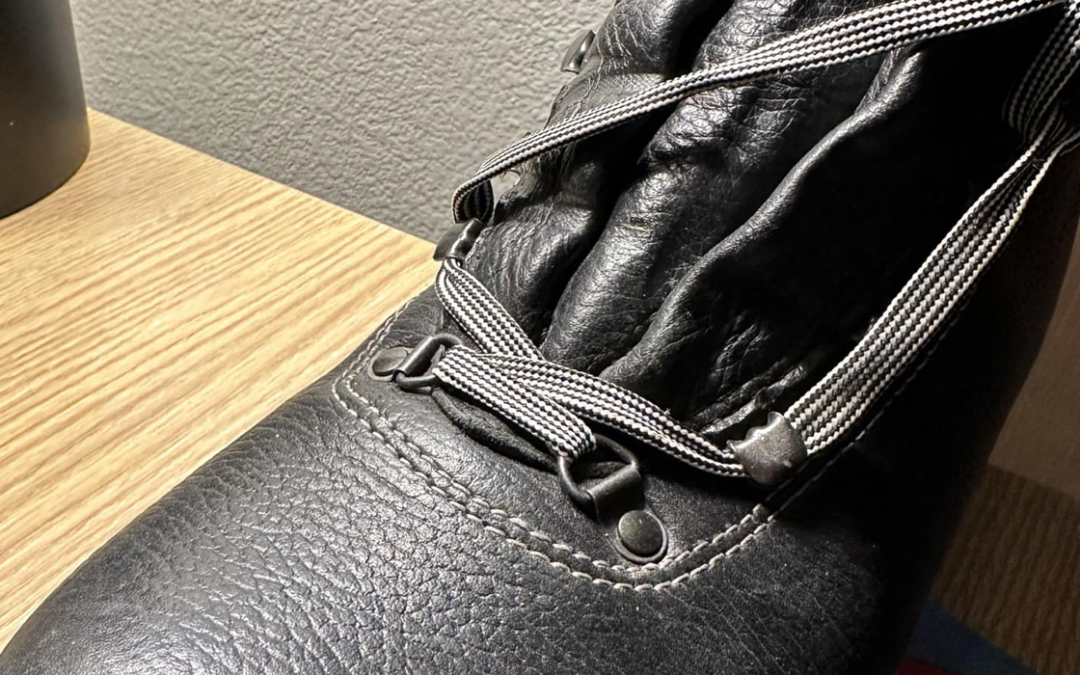Patience can accomplish a lot of things.
I have said in the past that I’ve taken two models of these traditionally-made leather hiking boots fresh out of their boxes at the Kennedy Meadows (south) trailhead and never got a blister. Yes, that actually did happen…but not this time!
The brand new Limmer boots that I posted about last week will require a break-in period before they fit like a glove and become confidence-inspiring tools on my feet, but what will that take?
On their maiden voyage last Saturday, they reminded me of how well-made and resistant to compliance they were! I didn’t get any blisters, but my desk-jockey feet were sure wondering what the hell I was doing! 
Update (two, wearing-and-walking days later):
After the hiking boot take-over years ago by lightweight footwear that is soft right out of the box, people have forgotten how to prepare durable, long-lasting, and supportive leather hiking boots for the trail. So, let me remind both of us! There are two keys to this process, really – one deals with the boot and the other deals with us!
After leather is cleaned, dried, and “tanned,” it comes out pretty stiff and has to be softened, if it is to either move or be shaped over something with a curve, like your foot. In the making of a durable hiking boot, the thick, softened leather is molded over a wooden “last” (or block) shaped like your foot, then allowed to dry, which makes the shoe stiff.
So, for a new boot to flex or bend with each step, all you’ve got to do is soften the leather, again, until it is as supple as your favorite wallet, purse, or jacket…and that is helped along with oil or water, time, and repeated flexing.
That brings me to the second key that has to adjust to this softening process…us!
In my case, I didn’t have any oil, so I soaked (total submersion!) my new boots in two or three creeks over the distance of six miles, three days ago. This soaked the leather uppers and the leather mid-sole (the sole is rubber, so it will bend quite easily, but the thicker mid-sole will need a little help!).
Though I knew that I was doing what was needed to whip these puppies into submission, by the end of my first day, my feet were a little sore for the process, the boots were flexing a tiny bit, and we both were dry, though thunderstorms were massing overhead. I got in my car and heard myself say, “Be patient, Ned!”
In our modern world of immediate gratification, patience is a state of the will that has been forgotten. Yet, we are aware that people and pets, for example, often have to learn through repetition and that takes time and an “understanding” of the teacher’s or trainer’s will that is otherwise called, “patience.”
As I drove home, barefoot, I had to remind myself that stiff leather doesn’t become soft leather overnight, by nature of its thick medium, so I was going to have to be patient and continue its “training.”
Timeline:
Saturday, I started teaching my boots about hiking and reminding myself about patience.
Sunday, I let both trainee and trainer rest.
Monday, I put my new Limmer Standards back on and went to work, albeit, sitting at a desk. I did some walking and stairs and noted that they were becoming a little more “bouncy” as they started flexing across the toes and in front of the ankles.
By the end of Tuesday, they were becoming “comfortable.”
Today (Wednesday), they had softened sufficiently to flatten over the toes, spread slightly wider across the balls of my feet, and flex nicely under my laces to where I could easily roll off my toes and push forward on the uphills (such as there are in an office building).
What I have ended up with is:
1) a soft, comfortable, leather boot that is wonderfully form-fitted to my feet,
2) durable (by nature of the leather),
3) supportive to my ankles (because they are over-the-ankle in height),
4) maintainable to last a lifetime,
5) waterproof on the outside (yet, breathable on the inside due to sock spacing and foot action) and,
6) resoleable (by the design inclusion of a Norwegian welt)!
Boots are not for everyone, but they can be the preference of some. Compared to the 2-4-week break-in time required of my Vasque “Whitney” boots that I used to thru-hike the PCT (1974) and CDT (1980), these new, Limmer workhorses softened up and learned their trade in no time!
[It needs to be said that neither Mountain Education nor I am sponsored by Limmer Boot. I just trust my life to their renowned comfort and performance.]

